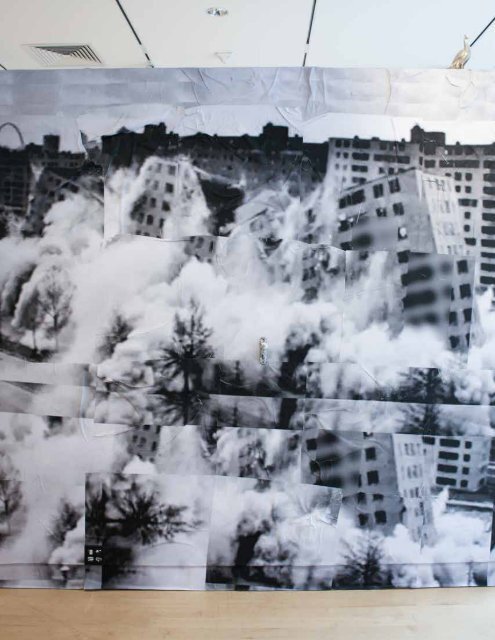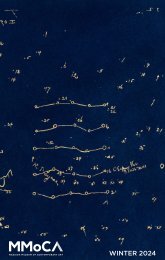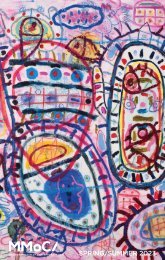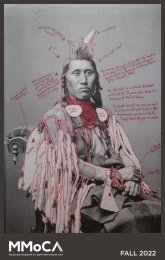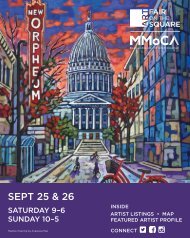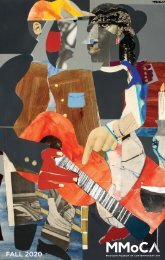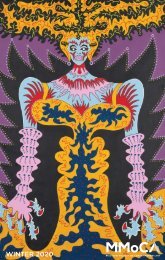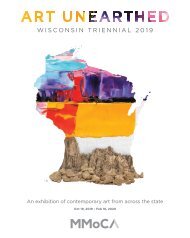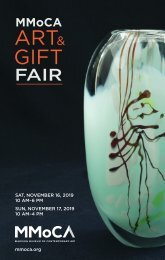Kambui Olujimi: Zulu Time exhibition catalog
This catalog is from the installation of this exhibition at MMoCA. It includes essays by Sampada Aranke, Leah Kolb, and Gregory Volk.
This catalog is from the installation of this exhibition at MMoCA. It includes essays by Sampada Aranke, Leah Kolb, and Gregory Volk.
Create successful ePaper yourself
Turn your PDF publications into a flip-book with our unique Google optimized e-Paper software.
POETICS<br />
of (IN)VISIBILITY<br />
Leah Kolb<br />
In <strong>Zulu</strong> <strong>Time</strong>, <strong>Kambui</strong> <strong>Olujimi</strong> presents a body of work that<br />
plays with notions of visibility, gesturing towards socio-economic<br />
infrastructures and political systems whose authority relies on the very<br />
absence of detectability. In a clever parallel, <strong>Olujimi</strong> similarly disguises<br />
his artwork’s own power by eschewing the literal. In refusing to give<br />
visual form to what he specifically references, the artist asks us to<br />
look behind, around, under, and through his objects and images—to<br />
consider what might be absent or obscured as much as what is present<br />
and tangible. His artworks become simultaneous presentations of<br />
visibility and invisibility, and demand a metaphorical slowing down of<br />
time to allow for careful, contemplative observation.<br />
<strong>Time</strong> itself manifests as the most invisible yet pervasive<br />
force in this <strong>exhibition</strong>. <strong>Zulu</strong> <strong>Time</strong>—the phonetic pronunciation of<br />
Z-<strong>Time</strong>—refers to Coordinated Universal <strong>Time</strong> (formerly Greenwich<br />
Mean <strong>Time</strong>), the world’s standardized mode of tracking time. Specifically,<br />
it references the time at the prime meridian (longitude 0 degrees),<br />
the invisible and ultimately arbitrary line from which all global time<br />
zones are calculated. Since Great Britain was the world’s foremost<br />
maritime power when the concept of latitude and longitude originated,<br />
the starting point for designating longitude is based on the location<br />
of the British Naval Observatory. Thus, <strong>Zulu</strong> <strong>Time</strong> literally revolves<br />
around Western norms for structuring a day. 1 This notion of universal<br />
time as an intangible yet ever-present expression of dominance and<br />
an imposition of control—a residue of Empire—serves as <strong>Olujimi</strong>’s<br />
jumping off point for creating two- and three-dimensional works that<br />
explore entrenched hierarchies and power disparities, while questioning<br />
assumptions underlying our understanding of the world at large.<br />
Consider InDecisive Moments, a series of four hourglassshaped<br />
vessels with craggy protrusions, resembling icebergs, that<br />
extend inward on either end. The bottom section of each hourglass<br />
is partially filled with water, further reinforcing the visual allusion<br />
1. Dava Sobel details the politics, history, and<br />
science of global mapping and timekeeping<br />
in Longitude: The True Story of a Lone Genius<br />
Who Solved the Greatest Scientific Problem of<br />
His <strong>Time</strong> (New York: Penguin Books, 1995).<br />
Regarding the arbitrary nature of the prime<br />
meridian, she writes: “As the world turns, any<br />
line drawn from pole to pole may serve as well<br />
as any other starting line of reference. The<br />
placement of the prime meridian is a purely<br />
political decision.” (4).<br />
17


